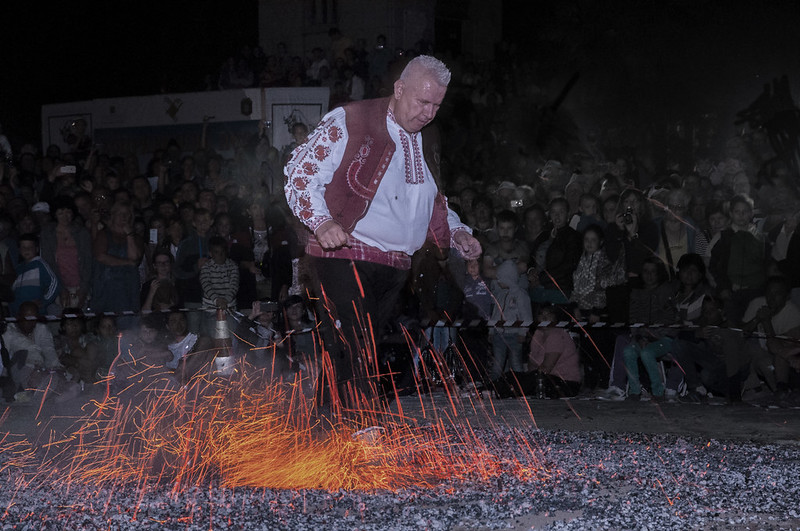Anastenaria
A Mystical Festival of Fire and Faith in Northern Greece
2026/05/20 - 2026/05/22
Every May, in several villages of northern Greece, the air fills with the scent of incense and burning wood, the rhythm of drums, and a unique sense of anticipation. Anastenaria is a three-day festival centered on the barefoot firewalking ritual, where ancient mystery and Christian faith intertwine. For those seeking a spiritual experience, wanting to feel traditional culture firsthand, or wishing to witness the power of community, Anastenaria is a festival that stirs all five senses.
The main locations are villages such as Agia Eleni, Langadas, and Kerkini. As the sun sets and the embers glow red, the boundary between the ordinary and the extraordinary dissolves, and the village is enveloped in heat, rhythm, and the power of faith.
Main Attractions
Ecstatic Dance, Sacred Icons, and the Firewalking Ritual
The climax of Anastenaria is the firewalking ritual, but the entire festival is filled with sacred experiences that stimulate the senses of sight and sound. It begins in the “konaki,” a prayer room adorned with red scarves and icons of Saints Constantine and Helen, where villagers gather. To the trance-like music of Thracian lyra, drums, and bagpipes, participants dance for hours. The room fills with the scent of sweat and incense and an air of exhilaration, as dancers are believed to enter a state of possession by the saints.
On the night of May 21, a large bonfire is lit in the village square. When the wood burns down to glowing coals, the Anastenarides (firewalkers) take icons and sacred objects in hand and dance around the fire. Then, one by one, they slowly walk barefoot across the burning coals. The expressions illuminated by the flames and the breathless silence of the crowd create a truly mystical scene. People from all over the world visit these villages to witness this miraculous moment.
Costumes, Decorations, and Ritual Offerings
Participants typically wear white or simple clothing, with red scarves (simadia) tied around their necks or heads, believed to hold the power of the saints. The icons are adorned with votive offerings and red cloth, and the konaki is filled with candles, incense, and flowers, creating a sacred atmosphere. Processions through the village, animal sacrifices in some traditions, and communal meals are also part of the festival.
Cultural and Historical Background
The origins of Anastenaria are a blend of legend and scholarly theory. According to local tradition, the ritual began in the 13th century when, during a church fire in the village of Kosti on the Black Sea coast, those who rescued the icons of Saints Constantine and Helen emerged unharmed. This event became a symbol of “the saints’ protection,” and ever since, villagers have continued the firewalking ritual as an act of faith and gratitude.
On the other hand, ethnologists and researchers trace Anastenaria’s roots even further back. They point to connections with the Dionysian cults and ancient fire festivals of Thrace, suggesting that these pagan rituals survived by adapting to Christianity. Indeed, the trance-like dancing and the reverence for fire seen in the ceremony strongly echo ancient nature worship and fertility rites.
Today, Anastenaria is preserved in villages as a unique tradition that blends devotion to Saints Constantine and Helen with both Christian and pre-Christian elements. The firewalking ritual symbolizes faith, communal renewal, the power of the soul to overcome pain and hardship, and the message that “life is cyclical and always renewed.” While the Orthodox Church does not officially recognize the ritual, for villagers it remains a source of identity, memory, and resilience.
Participant Voices
Standing in the square, surrounded by the scent of smoke and the sound of drums, I felt the energy rise as the dancers circled the fire. When the first firewalker stepped onto the coals, the entire audience held its breath. It was truly overwhelming. The music, the trance, and the firewalking felt like another world. A local told me, “If the saint calls you, the fire is no longer your enemy,” and seeing them walk across the coals, I almost believed it.
Fun Facts
- The firebed can reach temperatures of up to about 535°C (995°F), but participants rarely suffer burns.
- Anastenaria is only performed in a handful of villages in northern Greece (such as Agia Eleni, Langadas, and Kerkini) and southern Bulgaria.
- Only those who feel “called by the saints” attempt the firewalk; not everyone participates.
- The festival’s music centers on the Thracian lyra, gaida (bagpipes), and drums, creating a unique trance atmosphere.
Festival Dates
Anastenaria is held annually from May 21 to 23 in villages such as Agia Eleni, Langadas, and Kerkini in northern Greece. For the most authentic experience, it’s recommended to visit the real village rituals rather than tourist-oriented shows.
The event schedule is subject to change. Please check the official website for the most up-to-date information.
Information
| Name | Anastenaria |
| Country | Greece |
| Area | Agia Eleni and Langada |
| Date | 2026/05/20 - 2026/05/22 |
| Link |
Upcoming Festivals
Whirling Dervishes Festival Turkey
A Mesmerizing Dance of Divine Love
2025/12/06Mevlana Celaleddin Rumi Commemoration Ceremony ( Şeb-i Arus ) Turkey
A Whirling Journey to Divine Love
2025/12/10Dia de la Virgen de Guadalupe Mexico
A Festival Weaving Faith, Fervor, and Mexican Identity
2025/12/11L'Escalade Switzerland
Geneva’s Grand Winter Festival of Courage, Chocolate, and Community
2025/12/12Umkhosi Wokweshwama South Africa
The Zulu First Fruits Festival—A Sacred Celebration of Land, Ancestors, and Renewal
2025/12/12Lucia Festival (St. Lucia's Day) Sweden
A Festival of Light Illuminating the Nordic Darkness
2025/12/15Las Posadas Mexico
The Luminous Quest for Sacred Shelter
2025/12/22Noche de Rabanos (Night of the Radishes) Mexico
A celebration blending art, farming heritage, and cultural traditions
2025/12/23Chant of the Sybil on Majorca Spain
A Medieval Prophecy Echoes Through Majorcan Christmas
2025/12/23‘Hatajo de Negritos’ and the ‘Hatajo de Pallitas’ Peru
A Christmas Festival of Rhythm, Faith, and Afro-Andean Heritage in Peru’s Ica Region


